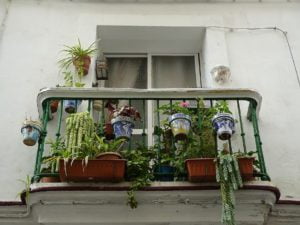Hanging baskets

Study Material For DDA SO (Horticulture)
The traditional hanging basket is a simple suspended container used for growing decorative plants. Typically they are hung from buildings, where garden space is at a premium, and from street furniture for environmental enhancement. One type of hanging basket is the inverted planter where plants are grown in an upside down pot and are watered from the top
Question:-The Hanging Gardens is located in which city?
- Iran
- Iraq (Babylon)
- Egypt
- Pakistan
Question:-The Hanging Gardens is located in which city of India?
- Bhopal
- Allahbad
- Mumbai
- Delhi
Question:- Flowering annuals suitable for hanging basket?
Ans: Verbena, Portulaca
Best hanging basket plants
| Chlorophytum | Lobelia | Pelargonium |
| Hoya, Pilea | Tradescantia | Hedra |
| Episcia | Campanula | Fuchsia |
| Setcreasea | Ferns | Selaginella |
| Philodendrons | Fittonia | Money plants |
| Begonia | Zebrina | Peperomia |
| Callisia | Zebrina | Plectranthus |
| Asparagus | Scindapsus | Orchids |
- Wire-framed baskets and other suspended containers are best planted so that the container itself is concealed by full and trailing growth.
- Hanging baskets are often hung as isolated features, perhaps to take advantage of an existing support.
- This might be an arc or the cross piece of a pergola, for example. Another approach is to fit specially made supporters for single or multiple hanging baskets.
- Brackets can be simple and inconspicuous, or ornamental and in a style that suits the surroundings.
- A hanging basket can make a dramatic focal point to enliven a blank wall, especially if it can be seen from a window or door. They can also be eye-catching when suspended from the corner of a building, but for safety they must be well above the highest of passers-by.
- Hanging baskets full of flowers or foliage plants give a colour boost to the house and garden. They can be used effectively even in a very small space.
- By selecting plants carefully, they can be changed to suit every season.
- Site selection is important for baskets. Hang the basket so that it will be close to eye level so that it can be admired as well as watered easily. Window boxes should extend the entire width of the window for best appearance.
- A light weight potting mix is needed for container gardening. Soil-less planting mixes provide excellent drainage, aeration and water-holding capacity that ordinary garden soil cannot supply.
- Drainage is essential so that the planting mix will not become water-logged.
- Plastic or wire baskets are ideal containers for hanging baskets
- Liners are used in wire hanging baskets to hold the soil and plants in position. Liners can be made of dried sphagnum moss or coconut fiber known as coir.
- Small, healthy, young plants are selected since they adapt to new surroundings much faster than older plants.
- Plants with a variety of colours, shapes and textures are planted.
- Daily or even twice-daily watering may be necessary since containers can dry out very quickly.
- Frequent watering flushes nutrients from the soil quickly and hence frequent fertilizing is also necessary.

Elevated eve-catcher:
- This vibrant combination of trailing plants ensures a long season of colour; they mask the basket, but the ornamental bracket can still be seen.
- The most obvious of the multiple arrangements are pairs of baskets, mounted, for example, either side of a door or combined with other containers.
- A handsome design can be created by using a large container, such as an urn, at ground level against a wall, with hanging baskets mounted above it and on either side.
- The plants in the hanging baskets may match or contrast with those in the large container.
For a more ambitious scheme, hanging baskets can be hung in rows, for example, on a series of arches, or on brackets along a wall. - Carefully coordinated or contrasting plantings can be dramatically staged by using a cast of smaller baskets either side of a large one, or by introducing variations in the height at which the containers are suspended.
- Using the cross-pieces of a pergola, a sequence of paired hanging baskets either side of a path makes an impressive avenue, although it is worth bearing in mind that such features will be time-consuming to water.
Containers & Medium:
- Choose a container, which is suitable for indoors.
- The standard wire basket lined with sphagnum moss is ideal for outdoors, but in the home you will have the problem of water dripping on to the floor.
- You can line the basket with polythene sheet, but water logging may then be a problem.
- The best answer is to put the pots of plants in a larger water proof container, which bears the holding wires, chains or cords.
- The space between the pots and the hanging container should be filled with moist peat.
- A variation is a plastic hanging pot with a built-in drip tray.
- Always use peat-based potting compost rather than a soil one-excess weight can be a problem.
Watering:
- Take basket at eye level to make easy watering or if you must suspend it over head-high then have a pulley arrangement instead of an ordinary hook.
- You can buy a pump-action watering can if the display cannot be lowered. Ensure that the hook is securely fixed to a ceiling joint or the bracket is firmly attached to the wall, and finally make sure that your choice of plants is suited to the light available flowering plants and variegated foliage house plants will need a spot near a window.
| More Horticulture Study Material | Open |
| More Agriculture Study Material | Open |
| Premium Study Material & Test Series | Open |